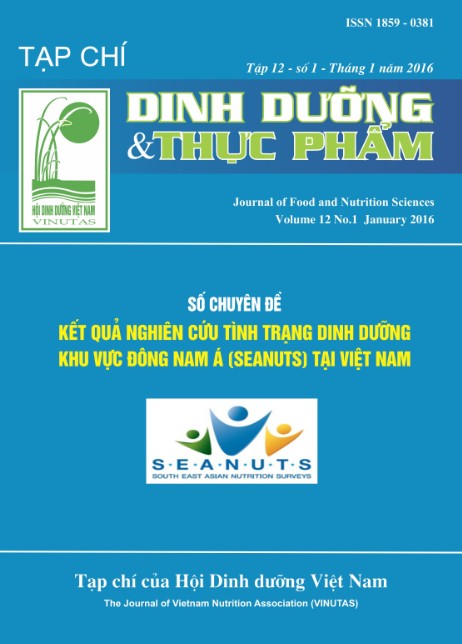PREVALENCE OF SUB-CLINICAL VITAMIN A DEFICIENCY AMONG PRIMARY SCHOOL CHILDREN IN 2012
Main Article Content
Abstract
A cross-sectional study has been conducted in 388 aged 6-11 to investigate the prevalence of sub-clinical vitamin A deficiency among primary school children in 6 provinces across Vietnam. Results: The prevalence of sub-clinical vitamin A deficiency among primary school children (serum retinol <0.7 µmol / L) was 7.7% (5.7% in urban and 9.7% in rural areas), while almost half of the children (48.9%) with marginal vitamin A deficiency (serum retinol ≥ 0.7 umol / L and <1.05 umol / L). There is a positive correlation between Hb concentration and serum retinol in school-aged children (Pearson correlation coefficient r = 0.14; p <0.01). Infection in children had 9.5 times increased risk (OR = 9.5, [5.1- 17.7]) for sub-clinical vitamin A deficiency (p<0.001). Conclusions: Children with subclinical vitamin A deficiency at mild level of public health significant problem. The prevention of micronutrient deficiencies should be promoted by appropriate interventions to improve the micronutrient status for children in the community in the future.
Article Details
Keywords
Sub-clinical vitamin A deficiency, marginal vitamin A deficiency, school children
References
2. de Pee, S. and O. Dary. Biochemical indicators of vitamin A deficiency: serum retinol and serum retinol binding protein. J Nutr, 2002. 132(9 Suppl): p. 2895S-2901S.
3. NIN/MOH/UNICEF. General Nutrition Survey 2009-2010. Medical Publishing House, Hanoi, 2010.
4. Nguyễn Xuân Ninh và CS. Đánh giá tình trạng thiếu vi chất dinh dưỡng tại 6 tỉnh miền núi phía Bắc, miền Trung và tây Nguyên, năm 2009. Báo cáo kết quả đề tài 2010.
5. Cardoso MA, Scopel KKG, Muniz PT, Villamor E, Ferreira MU. Underlying Factors Associated with Anemia in Amazonian Children: A Population-Based, Cross-Sectional Study. PLoS ONE. 2012; 7(5): e36341. doi:10.1371/journal.pone. 0036341
6. Chen L, Liu YF, Gong M, Jiang W, Fan Z, Qu P, Chen J, Liu YX, Li TY. Effects of vitamin A, vitamin A plus zinc, and multiple micronutrients on anemia in preschool children in Chongqing, China. Asia Pac J Clin Nutr. 2012;21(1):3-11.
7. Zimmermann MB, Biebinger R, Rohner F, Dib A, Zeder C, Hurrell RF, Chaouki N. Vitamin A supplementation in children with poor vitamin A and iron status increases erythropoietin and hemoglobin concentrations without changing total body iron. Am J Clin Nutr. 2006;84:580–6.
8. Evans T. Regulation Muñoz EC, Rosado JL, of hematopoiesis by retinoid signalling. Exp Hematol. 2005;33:1055–61.
9. López P, Furr HC, Allen LH. Iron and zinc supplementation improves indicators of vitamin A status of Mexican preschoolers. Am J Clin Nutr. 2000 Mar;71(3):789-94.
10.World Bank. School age children: Their Nutrition and Health. SCN News No 25. 2002.
11.Lam Nguyen Thi, Effect of vitamin A and iron fortified supplementary food on vitamin A and iron status of rural preschool children in Vietnam. Doctor thesis, University of Indonesia, 1997.


